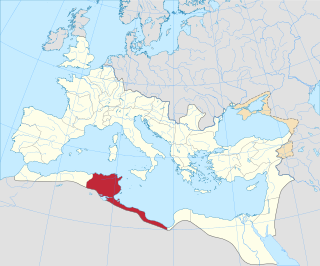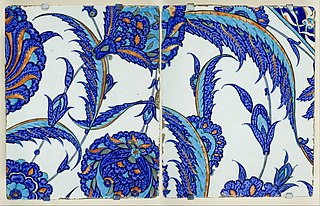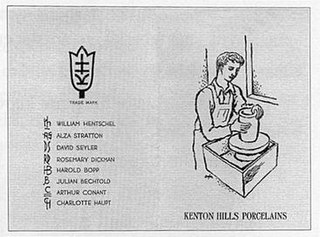
Louis Comfort Tiffany was an American artist and designer who worked in the decorative arts and is best known for his work in stained glass. He is the American artist most associated with the Art Nouveau and Aesthetic movements. He was affiliated with a prestigious collaborative of designers known as the Associated Artists, which included Lockwood de Forest, Candace Wheeler, and Samuel Colman. Tiffany designed stained glass windows and lamps, glass mosaics, blown glass, ceramics, jewellery, enamels, and metalwork. He was the first design director at his family company, Tiffany & Co., founded by his father Charles Lewis Tiffany.

Africa was a Roman province on the northern coast of what is now known as the African continent. It was established in 146 BC, following the Roman Republic's conquest of Carthage in the Third Punic War. It roughly comprised the territory of present-day Tunisia, the northeast of Algeria, and the coast of western Libya along the Gulf of Sirte. The territory was originally and still is inhabited by Berber people, known in Latin as Mauri, indigenous to all of North Africa west of Egypt. In the 9th century BC, Semitic Phoenicians from Western Asia built settlements along the coast of the Mediterranean Sea to facilitate shipping. Carthage, rising to prominence in the 8th century BC, became the predominant of these.

Hornsea Pottery was a business located in the coastal town of Hornsea in the East Riding of Yorkshire, England. They specialized in tableware with elegant contemporary designs.
North Dakota in the United States has been the scene of modern era pottery production using North Dakota clays since the early 1900s. In 1892 a study was published by Earle Babcock, a chemistry instructor at the University of North Dakota (UND) that reported on the superior qualities of some of the North Dakota clays for pottery production. The UND School of Mines began operations in 1898 with Earle Babcock as director. With the assistance of several eastern potteries, pottery made from North Dakota clay was first displayed at the 1904 St. Louis World's Fair.

Langley Mill Pottery was located in Langley Mill, Derbyshire on the Derbyshire – Nottinghamshire border. From its establishment in 1865 to its final closure in 1982, the pottery went through five distinct periods of ownership, producing a wide range of stoneware ranging from salt glazed ink bottles, utilitarian items and tableware to high quality and original art pottery.

The Midwinter Pottery was founded as W.R. Midwinter by William Robinson Midwinter in Burslem, Stoke-on-Trent in 1910 and had become one of England's largest potteries by the late 1930s with more than 700 employees. Production of Midwinter pottery ceased in 1987.
Puerto Rican Pottery was one of two potteries that established Mid Century Modern Pottery/Ceramics on the Island of Puerto Rico. The pottery operated from 1948–1966 in Santurce, Puerto Rico. It was a small pottery associated with and managed by master potter and ceramicist Hal Lasky.
W. Moorcroft Limited is a British art pottery manufacturer specialising in richly decorated earthenware. based at Burslem in Stoke-on-Trent, England. The company was founded by William Moorcroft in 1913.

Edison screw (ES) is a standard lightbulb socket for electric light bulbs. It was developed by Thomas Edison (1847–1931), patented in 1881, and was licensed in 1909 under General Electric's Mazda trademark. The bulbs have right-hand threaded metal bases (caps) which screw into matching threaded sockets. For bulbs powered by AC current, the thread is generally connected to neutral and the contact on the bottom tip of the base is connected to the "live" phase.

J. & G. Meakin was an English pottery manufacturing company founded in 1851 and based in Hanley, Stoke-on-Trent, Staffordshire.

Iznik pottery, or Iznik ware, named after the town of İznik in western Anatolia where it was made, is a decorated ceramic that was produced from the last quarter of the 15th century until the end of the 17th century.

The Roseville Pottery Company was an American art pottery manufacturer in the 19th and 20th centuries. Along with Rookwood Pottery and Weller Pottery, it was one of the three major art potteries located in Ohio around the turn of the 20th century. Though the company originally made simple household pieces, the Arts and Crafts–inspired designs proved popular, and Roseville pieces are now sought after by collectors.
Duffner & Kimberly was a New York City company which produced leaded glass and bronze lamps around the same time as Louis Comfort Tiffany, Tiffany Studios. The Duffner & Kimberly Company was formed in December 1905, with a capital outlay of $350,000. The firm introduced its first lamps in 1906.
Dorothy Jessie Tait was a prolific English ceramic designer working in the Stoke-on-Trent pottery industries, most prominently for Midwinter, from the 1940s to the 1980s.

Art pottery is a term for pottery with artistic aspirations, made in relatively small quantities, mostly between about 1870 and 1930. Typically, sets of the usual tableware items are excluded from the term; instead the objects produced are mostly decorative vessels such as vases, jugs, bowls and the like which are sold singly. The term originated in the later 19th century, and is usually used only for pottery produced from that period onwards. It tends to be used for ceramics produced in factory conditions, but in relatively small quantities, using skilled workers, with at the least close supervision by a designer or some sort of artistic director. Studio pottery is a step up, supposed to be produced in even smaller quantities, with the hands-on participation of an artist-potter, who often performs all or most of the production stages. But the use of both terms can be elastic. Ceramic art is often a much wider term, covering all pottery that comes within the scope of art history, but "ceramic artist" is often used for hands-on artist potters in studio pottery.

Pottery was produced in enormous quantities in ancient Rome, mostly for utilitarian purposes. Some of this pottery has been uncovered into the 21st century in the former territory of the Roman Empire, as well as in other parts of the world, especially in waste mounds such as Monte Testaccio.

The Grueby Faience Company, founded in 1894, was an American ceramics company that produced distinctive American art pottery vases and tiles during America's Arts and Crafts Movement.

Shelley Potteries, situated in Staffordshire, was earlier known as Wileman & Co. which had also traded as The Foley Potteries. The first Shelley to join the company was Joseph Ball Shelley in 1862 and in 1896 his son Percy Shelley became the sole proprietor, after which it remained a Shelley family business until 1966 when it was taken over by Allied English Potteries. Its china and earthenware products were many and varied although the major output was table ware. In the late Victorian period the Art Nouveau style pottery and Intarsio ranges designed by art director Frederick Alfred Rhead were extremely popular but Shelley is probably best known for its fine bone china “Art Deco” ware of the inter-war years and post-war fashionable tea ware.

Kenton Hills Porcelains were high-fired soft paste porcelain products manufactured by Kenton Hills Porcelains, Inc. Ceramics were produced from 1940 to 1943 in Erlanger, Kentucky, with sales continuing to 1944. All ceramic products were made from native clays. Products include vases, bookends, figurines, lamp bases, and flowerpots.

Stangl Pottery was a company in Flemington, New Jersey, that manufactured a line of dinnerware and other items. The company was originally founded as Samuel Hill Pottery in 1814, until 1860 when it became Fulper Pottery. The name changed to Stangl Pottery in 1955. The company ceased production and closed in 1978, but the dinnerware is still prized by collectors. Pieces can be identified by the Stangl name on the bottom. The original Flemington, New Jersey, location and showroom was bought in May 2011 to make space for a restaurant, a studio, and an art gallery.
















